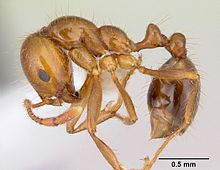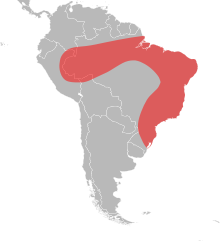Solenopsis saevissima
| Solenopsis saevissima | |
|---|---|
 |
|
| Solenopsis saevissima worker | |
| Scientific classification | |
| Kingdom: | Animalia |
| Phylum: | Arthropoda |
| Class: | Insecta |
| Order: | Hymenoptera |
| Family: | Formicidae |
| Genus: | Solenopsis |
| Species: | S. saevissima |
| Binomial name | |
|
Solenopsis saevissima (Smith, 1855) |
|
 |
|
| The natural range of Solenopsis saevissima | |
Solenopsis saevissima, commonly known in Brazil as formiga ruiva (red ant), is one of more than 185 species in the genus Solenopsis. It, along with 12 other species, is also a member of the Solenopsis saevissima species-group.
Although it's indigenous to South America, it has been imported to Africa and the Galápagos Islands. There used to be no evidence of it in the United States, but recently there have been discoveries of them in some of the southern states.S. saevissima is known for its powerful and painful sting, hence the name "fire ant". It is a pest in horticulture and the current method of control is to introduce the scuttle fly phorid into its habitat. No further information about S. saevissima and its behaviors is known or studied except in Brazil.
The scientific name for Solenopsis saevissima comes from the Greek: solen, which means pipe or channel, opsis, which means appearance or sight and the Latin saevissima, which means "the very cruel".S. saevissima is named so because it is known to be even more vicious than S. invicta, the red imported fire ants, which costs the United States millions of dollars per year in agricultural, medical, and traffic-related damage.
S. saevissima belongs to the Solenopsis saevissima species-group which includes 13 fire ant species that exhibit remarkably similar morphology, rendering morphological distinction nearly impossible.S. saevissima has polymorphic adult workers that differ in size depending on their castes: minor workers are generally smaller and major workers are relatively larger. The major workers also typically have trapezoidal heads and antennal scapes almost reaching their vertex; the minor workers have ovate heads and antennal scapes that extend past their heads.
...
Wikipedia
